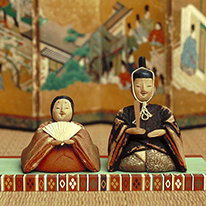- Feature Exhibition: The Doll Festival and Japanese Ningyō
- February 20, 2018-March 18, 2018
General Information
| Exhibition Title | Feature Exhibition: The Doll Festival and Japanese Ningyō |
|---|---|
| Period | February 20, 2018-March 18, 2018 |
| Venue | Heisei Chishinkan Wing (The Collections Galleries), Galleries 2F-5 |
| Transportation | JR, Kintetsu Railway, Keihan Railway, Hankyu Railway, City Bus / Map |
| Closed | Closed on Monday |
| Museum Hours | Tuesday - Thursday, Sunday: 9:30 a.m.-5:00 p.m. (Entrance Until 4:30 p.m.) Friday, Saturday: 9:30 a.m. - 8:00 p.m. (Entrance until 7:30 p.m.) |
| Admission |
Adult 520 yen (410 yen) Univ. Student 260 yen (210 yen) (Fees in parentheses are for groups of 20+) *Admission is free for youths of high school age and below. |
Images from the Exhibit
Hina dolls are associated with the Doll Festival, or Hina Matsuri, which takes place around March 3rd each year. Though widely considered to be an ancient ritual, the tradition of displaying and celebrating dolls on a specific day dates only to the early 1600s, in the Edo period. Some types of Edo period hina dolls are named after the time periods with which they are associated, as in the Kan’ei bina dolls (named after the Kan’ei era, 1624–1645) or Kyōho bina dolls (after the Kyōhō era, 1716–1736). The Jirozaemon bina dolls are named after a Kyoto doll maker, Jirōzaemon. The kokin bina dolls are considered to be a new Edo period innovation, while the yūsoku bina courtier dolls faithfully represent the costume and hair conventions of the aristocracy. Also on view are other types such as Saga, Gosho, Kamo, and Fushimi ningyō (dolls), which are named after geographic locales in Kyoto. This extensive selection of dolls offers the opportunity carefully at differences in their details, including facial expressions, gestures, and costumes.












